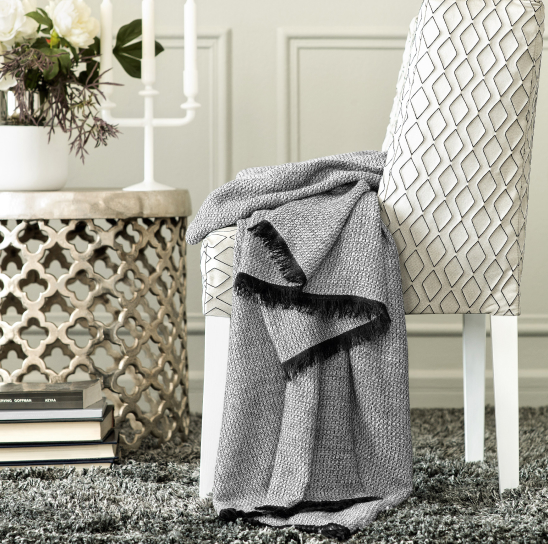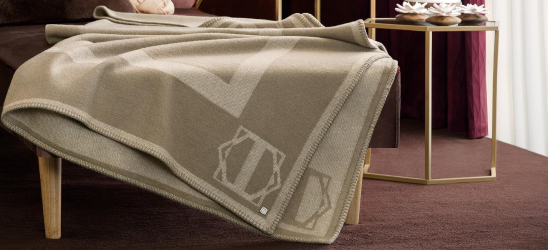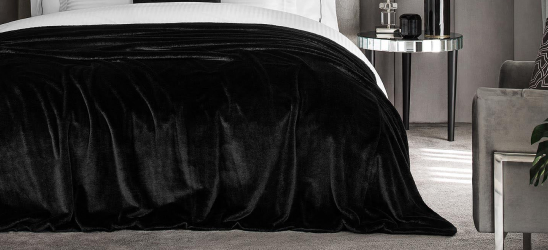How to wash throw blankets and bedspreads: Caring for different types of fabric
Everyone has their favorite throw blanket. The one you snuggle up with in the evening while watching TV. Or the one you drape over your shoulders so you can go sit outside on the porch and enjoy a steamy cup of coffee or tea on an especially chilly morning.
Large throws can serve as gorgeous accent pieces, setting the style of your room and replacing a bedspread or summer duvet.
Caring for throws and bedspreads is a tad more of a hassle than for bed linen or towels, since more often than not they are made of cotton fabrics, which are a lot easier to remove stains from. Usually, a wool blanket requires special care and attention.
Of course, if your throw is made of artificial materials (such as acrylic), it can be machine washed, and it will dry quickly. Such products don’t really wrinkle, and have good shape retention properties.
What is the best way to wash blankets and throws made of various fabrics?
Throws made of wool

Wool blankets are some of the most common throw coverings. It’s better to take wool items to the dry cleaners instead of taking risks with machine washing and potentially ruining them. Valuable wool's such as cashmere cannot be machine washed.
This delicate material will deform, pill, and lose its natural beauty and softness. Alpaca fleece, merino, and angora are all materials that are risky to machine wash as well.
Care tips for such items:
• Do not wash
• Do not bleach
• Dry-clean only
• Do not tumble dry
One way to clean your throw at home is by using a roller with one-sided adhesive paper on a spindle. It works best for removing lint, hair, and down. This method is perfect if you need to remove excessive amounts of pet hair from your throw. You can use adhesive tape refills or a reusable roller.

Another way to get rid of unwanted dust and odors in your throw is the good old-fashioned snow cleaning method. Remember how our grandmothers used to beat rugs in the snow? This method proved to be very successful for shaking out the dust, and a natural way of airing out those unsavory odors which will leave your throw refreshed.
Gently brush the fabric on both sides in clean, dry snow. This method may have been forgotten by most, but it is actually still effective today, and has withstood the test of time.
Cotton and silk-based throw blankets

You need to be extra careful with throws made of other natural fabrics (e.g., cotton or silk). Such natural fabrics are very delicate and require special care. Only professional dry cleaning is suitable for these items.
Throws and bedspreads made from cotton or blended fabrics (e.g., a combination of cotton and modal or viscose in light summer models) are more practical compared to natural silk. It is possible to machine wash such throws or wash them manually at home.

Here are the care tips for them:
• Machine wash at 30°C
• Gentle detergent (preferably liquid)
• Low-speed spins
• We recommend drying cotton knitted throws on a horizontal surface to avoid deforming or stretching the fabric.
Fleece throw blankets
Knowing how to wash throw blankets is essential if you work in a home textile store, especially if the throw blankets are fleece. Follow the care instructions exactly, because fleece blankets can be sensitive. Check the washing instructions on the care label first.If you’re using a washing machine, wash a fleece throw separately in warm or cool water, using a moderate cycle and a mild detergent. Fabric softener should be avoided because it can harm the fleece's fibers.
To avoid creases, take the blanket out of the washer as soon as possible, and don't wring or twist it. Instead, give it a gentle shake before laying it flat or hanging it to dry naturally. In order to protect the fleece fibers, keep it out of the sun and extreme heat.
You can keep your throw blanket comfortable and clean for many years by following these instructions.
In conclusion, when you wash fleece blankets, always read the care label, wash separately, use a gentle cycle, avoid using fabric softener, air dry by laying flat or hanging, avoid using direct sunlight, and avoid high heat.
Blankets with faux fur and synthetic fibers

It's crucial to adhere to the manufacturer's directions when cleaning faux fur throw blankets for optimum results. These blankets can typically be washed in the washing machine on a gentle cycle with cold water and mild detergent.
It's crucial to avoid using bleach or fabric softeners because they can harm the faux fur fibers. To avoid any damage, it is advised to air dry the blanket after washing rather than placing it in the dryer.
It's also crucial to keep in mind that faux fur blankets need special cleaning instructions to preserve their softness and look. If you keep your throw bedspread clean and in good condition, it will last longer, and continue to keep you cozy on many more chilly evenings.
Believe it or not, you can care for products made of beautiful, plush faux fur at home. These items are machine washable by setting a delicate mode at 30°C.

The “Amara” collection from Togas features several faux fur bedspreads that are soft to the touch, fluffy, and gorgeous. These models are designed to resemble the fur of many animals, such as black panthers, rabbits, and chinchillas.
They are designed for people who love the softness and puffiness of real fur, yet have decided on more practical and ethical options.
H2: How are thick throw blankets washed?
To maintain the quality of heavy throw blankets, it is crucial to wash them according to the recommended care instructions. For any specific washing instructions, first check the care label.
To avoid causing any harm to the blanket's fibers, wash it in cool or lukewarm water on a gentle cycle. Avoid using hot water or a vigorous cycle, as this can result in shrinking or pilling. In order to avoid tangling or machine damage, it is also advisable to wash heavy blankets separately.
These easy suggestions will help you keep your weighted blankets warm and clean for many years to come.
Difficult stains
Have you ever accidentally got gum stuck in your throw? Removing and cleaning it can most definitely be a hassle. So what is the best way to get rid of it? One easy answer is to take it to the dry cleaners, but there is another common method to try if you have an inexpensive faux fur item on your hands. Put it in the freezer.Make sure the gum is on the outside when you put in the throw, and fold it in a bag. After an hour in the freezer, the frozen gum will easily peel off the fabric. If the throw is large and doesn’t fit, what do you do then? Another option is to purchase a gum removal spray (dry chemical ice).
Or, say, you have a stain from paraffin or candle wax. You're having a romantic candlelight dinner with your partner, and afterwards you realize wax has dropped down onto your favorite tablecloth or throw. Well the methods mentioned above for removing gum can help remove wax as well.
How can throw blankets be dried?
It's crucial to adhere to the manufacturer's care directions when it comes to drying throw blankets. In general, air drying or hang drying are reliable options for most throw blankets. Laying the throw blanket flat on a spotless, dry surface will allow it to air dry.Alternatively, you might allow the throw blankets to hang dry on a drying rack or clothesline. Before using the throw blanket once more, make sure it is dry completely to prevent mildew and odors.
To prevent fabric damage, it's important to first check the care label on any throw bedcovers that you can tumble dry on low heat.
How frequently must I wash throw blankets?
Throw blankets should be washed on a regular basis or as soon as they begin to smell or appear soiled. Washing most throw blankets can be done by machine washing without issue, but some delicate or polyester blankets might need to be done by hand washing or be dry cleaned.Use a gentle cycle with cold water and the manufacturer's instructions, which include using laundry detergent to remove dirt and pet hair.






